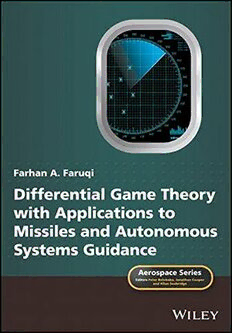Table Of ContentDifferential Game Theory with Applications to
Missiles and Autonomous Systems Guidance
FarhanA.Faruqi
DefenceScience&TechnologyOrganisation
Australia
Thiseditionfirstpublished2017
©2017JohnWiley&SonsLtd
LibraryofCongressCataloging-in-PublicationData
Names:Faruqi,FarhanA.,1944–author.
Title:Differentialgametheorywithapplicationstomissilesandautonomoussystemsguidance/FarhanA.Faruqi.
Othertitles:Aerospaceseries(Chichester,England)
Description:Hoboken,NJ:JohnWiley&Sons,2017.|Series:Aerospaceseries|Includesbibliographicalreferencesand
index.
Identifiers:LCCN2017000484(print)|LCCN2017008046(ebook)|ISBN9781119168478(cloth)|
ISBN9781119168508(pdf)|ISBN9781119168492(epub)
Subjects:LCSH:Guidedmissiles–Guidancesystems–Mathematicalmodels.|Guidedmissiles–Control
systems–Mathematicalmodels.|Differentialgames.|Gametheory.
Classification:LCCUG1310.F372017(print)|LCCUG1310(ebook)|DDC623.4/519–dc23
LCrecordavailableathttps://lccn.loc.gov/2017000484
Setin10/12ptWarnockProbyAptaraInc.,NewDelhi,India
PrintedinGreatBritainbyTJInternationalLtd,Padstow,Cornwall
Contents
Preface xi
Acknowledgments xiii
AbouttheCompanionWebsite xv
DifferentialGameTheoryandApplicationstoMissileGuidance 1
Nomenclature 1
Abbreviations 2
1.1 Introduction 2
1.1.1 NeedforMissileGuidance—Past,Present,andFuture 2
1.2 GameTheoreticConceptsandDefinitions 3
1.3 GameTheoryProblemExamples 4
1.3.1 Prisoner’sDilemma 4
1.3.2 TheGameofTic-Tac-Toe 6
1.4 GameTheoryConceptsGeneralized 8
1.4.1 Discrete-TimeGame 8
1.4.2 Continuous-TimeDifferentialGame 9
1.5 DifferentialGameTheoryApplicationtoMissileGuidance 10
1.6 Two-PartyandThree-PartyPursuit-EvasionGame 11
1.7 BookChapterSummaries 11
1.7.1 ANoteontheTerminologyUsedIntheBook 13
References 14
OptimumControlandDifferentialGameTheory 16
Nomenclature 16
Abbreviations 17
2.1 Introduction 17
2.2 CalculusofOptima(MinimumorMaximum)foraFunction 18
2.2.1 OntheExistenceoftheNecessaryandSufficientConditions
foranOptima 18
2.2.2 SteadyStateOptimumControlProblemwithEqualityConstraints
UtilizingLagrangeMultipliers 19
2.2.3 SteadyStateOptimumControlProblemforaLinearSystemwith
QuadraticCostFunction 22
2.3 DynamicOptimumControlProblem 23
2.3.1 OptimalControlwithInitialandTerminalConditionsSpecified 23
2.3.2 Boundary(Transversality)Conditions 25
2.3.3 SufficientConditionsforOptimality 29
2.3.4 ContinuousOptimalControlwithFixedInitialConditionand
UnspecifiedFinalTime 30
2.3.5 AFurtherPropertyoftheHamiltonian 35
2.3.6 ContinuousOptimalControlwithInequalityControlConstraints—
thePontryagin’sMinimum(Maximum)Principle 36
2.4 OptimalControlforaLinearDynamicalSystem 38
2.4.1 TheLQPIProblem—FixedFinalTime 38
2.5 OptimalControlApplicationsinDifferentialGameTheory 40
2.5.1 Two-PartyGameTheoreticGuidanceforLinearDynamicalSystems 41
2.5.2 Three-PartyGameTheoreticGuidanceforLinearDynamicalSystems 44
2.6 ExtensionoftheDifferentialGameTheorytoMulti-PartyEngagement 50
2.7 SummaryandConclusions 50
References 51
Appendix 53
DifferentialGameTheoryAppliedtoTwo-PartyMissileGuidance
Problem 63
Nomenclature 63
Abbreviations 64
3.1 Introduction 64
3.2 DevelopmentoftheEngagementKinematicsModel 67
3.2.1 RelativeEngageKinematicsofnVersusmVehicles 68
3.2.2 Vector/MatrixRepresentation 69
3.3 OptimumInterceptor/TargetGuidanceforaTwo-PartyGame 70
3.3.1 ConstructionoftheDifferentialGamePerformanceIndex 70
3.3.2 WeightingMatricesS,Rp,Re 72
3.3.3 SolutionoftheDifferentialGameGuidanceProblem 73
3.4 SolutionoftheRiccatiDifferentialEquations 75
3.4.1 SolutionoftheMatrixRiccatiDifferentialEquations(MRDE) 75
3.4.2 StateFeedbackGuidanceGains 76
3.4.3 SolutionoftheVectorRiccatiDifferentialEquations(VRDE) 77
3.4.4 AnalyticalSolutionoftheVRDEfortheSpecialCase 78
3.4.5 MechanizationoftheGameTheoreticGuidance 79
3.5 ExtensionoftheGameTheorytoOptimumGuidance 79
3.6 RelationshipwiththeProportionalNavigation(PN)andthe
AugmentedPNGuidance 81
3.7 Conclusions 82
References 82
Appendix 84
Three-PartyDifferentialGameTheoryAppliedtoMissileGuidance
Problem 102
Nomenclature 102
Abbreviations 103
4.1 Introduction 103
4.2 EngagementKinematicsModel 104
4.2.1 Three-PartyEngagementScenario 105
4.3 Three-PartyDifferentialGameProblemandSolution 107
4.4 SolutionoftheRiccatiDifferentialEquations 111
4.4.1 SolutionoftheMatrixRiccatiDifferentialEquation(MRDE) 111
4.4.2 SolutionoftheVectorRiccatiDifferentialEquation(VRDE) 112
4.4.3 FurtherConsiderationofPerformanceIndex(PI)Weightings 115
4.4.4 GameTerminationCriteriaandOutcomes 116
4.5 DiscussionandConclusions 116
References 117
Appendix 118
FourDegrees-of-Freedom(DOF)SimulationModelforMissileGuidance
andControlSystems 125
Nomenclature 125
Abbreviations 126
5.1 Introduction 126
5.2 DevelopmentoftheEngagementKinematicsModel 126
5.2.1 TranslationalKinematicsforMulti-VehicleEngagement 126
5.2.2 Vector/MatrixRepresentation 128
5.2.3 RotationalKinematics:RelativeRange,RangeRates,SightlineAngles,
andRates 128
5.3 VehicleNavigationModel 130
5.3.1 ApplicationofQuaterniontoNavigation 131
5.4 VehicleBodyAnglesandFlightPathAngles 133
5.4.1 ComputingBodyRates(p,q,r) 134
i i i
5.5 VehicleAutopilotDynamics 135
5.6 AerodynamicConsiderations 135
5.7 ConventionalGuidanceLaws 136
5.7.1 ProportionalNavigation(PN)Guidance 136
5.7.2 AugmentedProportionalNavigation(APN)Guidance 137
5.7.3 OptimumGuidanceandGameTheory–BasedGuidance 137
5.8 OverallStateSpaceModel 138
5.9 Conclusions 138
References 139
Appendix 140
Three-PartyDifferentialGameMissileGuidanceSimulationStudy 150
Nomenclature 150
Abbreviations 150
6.1 Introduction 151
6.2 EngagementKinematicsModel 151
6.3 GameTheoryProblemandtheSolution 154
6.4 DiscussionoftheSimulationResults 157
6.4.1 GameTheoryGuidanceDemonstratorSimulation 157
6.4.2 GameTheoryGuidanceSimulationIncludingDisturbanceInputs 160
6.5 Conclusions 162
6.5.1 UsefulFutureStudies 162
References 163
Appendix 164
Addendum 165
Index 189
Preface
This book entitled Differential Game Theory with Applications to Missiles and
Autonomous Systems Guidance is an outgrowth of many years of the author’s experi-
enceinmissileguidanceandcontrolresearchanddevelopmentinaerospaceanddefense
organizationsintheUK,theUSAandAustralia.Someofthematerialincludedinthe
bookistheresultofcoursestaughttoundergraduateandpost-graduatestudentsinuni-
versitiesintheUSAandAustralia.Thepurposeofthisbookistobringtotheattention
of researchers and engineers working in the field of aerospace guidance and control
systems recent developments in the field. There are a number of excellent books on
thetopicofclassical missileguidancetheory.Inthisbook theauthorhasendeavored
toapproachthetopicofmissileguidancefromtheoptimumgametheoryperspective.
It is shown that the classical guidance approach is closely linked to this approach; in
fact,itisdemonstratedinChapter3thattheclassicalapproachissimplyaspecialcase
ofthemodernoptimalgametheory.Thisapproachoffersresearchersandengineersa
widerchoiceofsystemanalysisandsynthesisoptionstoeffectivelydealwithcontinu-
ouslyevolvingchallengesofcurrentandfuturemissileandaircraftcombatscenarios.
AsnotedinChapter1,thegametheoryhasitsoriginsinthefieldofeconomics,busi-
ness,politicsandsocialsciences.Thesedevelopmentshavefoundtheirwayintosolv-
ingcomplexandchallengingproblemsinengineering,operationsresearch,andcombat
missionsystems.Readersandpractitionersinfieldsotherthanengineeringwillalsofind
this book useful, particularly Chapter 2 which lays down formal mathematical foun-
dations of the differential game theory. This should provide a useful background for
readers whose interests encompass economics, business or other areas. Game theory
approachestoproblemsolving,algorithmsandtheirapplicationstovariousfieldsare
progressing rapidly; evolutionary and quantum game theories, stochastic games, and
diagnosticmedicineapplicationsaresomeexamplesofthistrend.Thisbookhasbeen
writtentoprovideaformalandintegratedtextonthetopicofdifferentialgametheory
andshouldprovideessentialbackgroundtoundergraduateandpostgraduateresearch
studentsinengineering,mathematicsandsciencesubjects.Missileguidancesimulation
examples are given in Chapter 6 and a simulation demonstration website (MATLAB,
∗.m files) is included with this book (program listing is given in the addendum). This
resourceshouldprovidethereaderwithhands-onexperienceandwithatooltorein-
forcelearningintopicscoveredinthebook.
While this book is focussed on the application of the differential game theory to
the missile guidance problem, there are other applications which are closely linked
to this and are currently the subject of intense research. These applications include
autonomous and intelligent vehicle control; unmanned vehicle formation strategies;
UAVandaircraftcollisionavoidance;surveillanceandreconnaissance;andelectronic
counter-measure and counter-countermeasure deployment. It is hoped that students,
researchersandpracticingengineersinindustryandgovernmentaswellasinterested
readersinotherfieldswillfindthistextbothinterestingandchallenging.
FarhanA.Faruqi
CompanionWebsite
Don’tforgettovisitthecompanionwebsiteforthisbook:
www.wiley.com/go/faruqi/game
Thereyouwillfindvaluablematerialdesignedtoenhanceyourlearning,including:
(cid:2)
MATLABcodes
(cid:2)
DEMOcontent
DifferentialGameTheoryandApplicationstoMissileGuidance
Nomenclature
k: istheepoch(inadiscretetimegame).
P: isthesetofplayersinagame.
U: isthesetofstrategiesavailabletoalltheplayers.
Ui: isthesetofstrategiesavailabletoplayeri.
J (⋯): istheobjectivefunctionforplayersiandj.
ij
X : isthesetofcurrentstateofagameatepochk.
k
U : isthesetofstrategiesavailabletoaplayeratepochk.
k
u (k): isthestrategyvector(inputvector)availabletoplayeriagainstplayerjat
ij
epochk.
C : isthesetofconstraintsatepochk.
k
G : isthesetofelementsofadiscrete-timegame.
k
t: isthetimeinacontinuoustime(differential)game.
X : isthesetofstatesofagameattimet.
t
U : isthesetofstrategiesattimet.
t
u (t): isthestrategyvector(inputvector)availabletoplayeriagainstplayerjat
ij
timet.
C : isthesetofconstraintsattimet.
t
G : isthesetofelementsofacontinuoustime(differential)game.
t
x (t): istherelativestatevectorofplayeriw.r.t.playerjattimet.
ij
u(t): isthestrategyvector(inputvector)ofplayeri.
i
F: isthestatecoefficientmatrix.
G: istheinputcoefficientmatrix.
Q: isthePIweightingsmatrixonthecurrentrelativestates.
S: isthePIweightingsmatrixonthefinalrelativestates.
{R,R}: arePIweightingsmatricesoninputs.
i j

